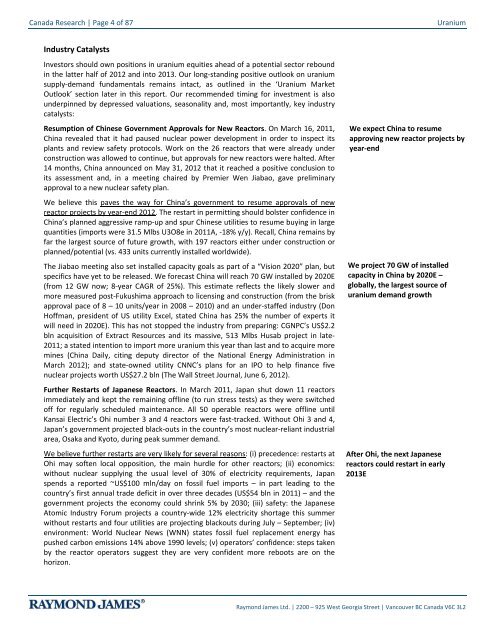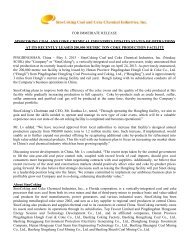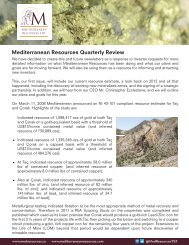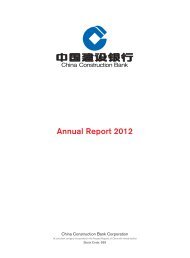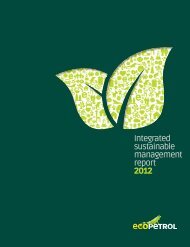Clock - Uranium Supply Crunch and Critical ... - Andrew Johns
Clock - Uranium Supply Crunch and Critical ... - Andrew Johns
Clock - Uranium Supply Crunch and Critical ... - Andrew Johns
- No tags were found...
Create successful ePaper yourself
Turn your PDF publications into a flip-book with our unique Google optimized e-Paper software.
Canada Research | Page 4 of 87<strong>Uranium</strong>Industry CatalystsInvestors should own positions in uranium equities ahead of a potential sector reboundin the latter half of 2012 <strong>and</strong> into 2013. Our long-st<strong>and</strong>ing positive outlook on uraniumsupply-dem<strong>and</strong> fundamentals remains intact, as outlined in the ‘<strong>Uranium</strong> MarketOutlook’ section later in this report. Our recommended timing for investment is alsounderpinned by depressed valuations, seasonality <strong>and</strong>, most importantly, key industrycatalysts:Resumption of Chinese Government Approvals for New Reactors. On March 16, 2011,China revealed that it had paused nuclear power development in order to inspect itsplants <strong>and</strong> review safety protocols. Work on the 26 reactors that were already underconstruction was allowed to continue, but approvals for new reactors were halted. After14 months, China announced on May 31, 2012 that it reached a positive conclusion toits assessment <strong>and</strong>, in a meeting chaired by Premier Wen Jiabao, gave preliminaryapproval to a new nuclear safety plan.We believe this paves the way for China’s government to resume approvals of newreactor projects by year-end 2012. The restart in permitting should bolster confidence inChina’s planned aggressive ramp-up <strong>and</strong> spur Chinese utilities to resume buying in largequantities (imports were 31.5 Mlbs U3O8e in 2011A, -18% y/y). Recall, China remains byfar the largest source of future growth, with 197 reactors either under construction orplanned/potential (vs. 433 units currently installed worldwide).The Jiabao meeting also set installed capacity goals as part of a “Vision 2020” plan, butspecifics have yet to be released. We forecast China will reach 70 GW installed by 2020E(from 12 GW now; 8-year CAGR of 25%). This estimate reflects the likely slower <strong>and</strong>more measured post-Fukushima approach to licensing <strong>and</strong> construction (from the briskapproval pace of 8 – 10 units/year in 2008 – 2010) <strong>and</strong> an under-staffed industry (DonHoffman, president of US utility Excel, stated China has 25% the number of experts itwill need in 2020E). This has not stopped the industry from preparing: CGNPC’s US$2.2bln acquisition of Extract Resources <strong>and</strong> its massive, 513 Mlbs Husab project in late-2011; a stated intention to import more uranium this year than last <strong>and</strong> to acquire moremines (China Daily, citing deputy director of the National Energy Administration inMarch 2012); <strong>and</strong> state-owned utility CNNC’s plans for an IPO to help finance fivenuclear projects worth US$27.2 bln (The Wall Street Journal, June 6, 2012).Further Restarts of Japanese Reactors. In March 2011, Japan shut down 11 reactorsimmediately <strong>and</strong> kept the remaining offline (to run stress tests) as they were switchedoff for regularly scheduled maintenance. All 50 operable reactors were offline untilKansai Electric’s Ohi number 3 <strong>and</strong> 4 reactors were fast-tracked. Without Ohi 3 <strong>and</strong> 4,Japan’s government projected black-outs in the country’s most nuclear-reliant industrialarea, Osaka <strong>and</strong> Kyoto, during peak summer dem<strong>and</strong>.We believe further restarts are very likely for several reasons: (i) precedence: restarts atOhi may soften local opposition, the main hurdle for other reactors; (ii) economics:without nuclear supplying the usual level of 30% of electricity requirements, Japanspends a reported ~US$100 mln/day on fossil fuel imports – in part leading to thecountry’s first annual trade deficit in over three decades (US$54 bln in 2011) – <strong>and</strong> thegovernment projects the economy could shrink 5% by 2030; (iii) safety: the JapaneseAtomic Industry Forum projects a country-wide 12% electricity shortage this summerwithout restarts <strong>and</strong> four utilities are projecting blackouts during July – September; (iv)environment: World Nuclear News (WNN) states fossil fuel replacement energy haspushed carbon emissions 14% above 1990 levels; (v) operators’ confidence: steps takenby the reactor operators suggest they are very confident more reboots are on thehorizon.We expect China to resumeapproving new reactor projects byyear-endWe project 70 GW of installedcapacity in China by 2020E –globally, the largest source ofuranium dem<strong>and</strong> growthAfter Ohi, the next Japanesereactors could restart in early2013ERaymond James Ltd. | 2200 – 925 West Georgia Street | Vancouver BC Canada V6C 3L2


